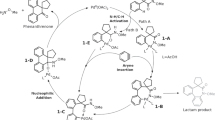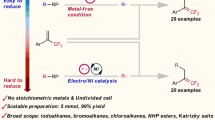Abstract
Nucleophilic substitution on the aromatic ring (SNAr) is a very important reaction for organic transformations. This kind of reaction is usually difficult to take place, requiring organometallic catalysis or activation of the ring by electron withdrawing groups to turn the nucleophilic attack possible. In this work, the relative importance of intrinsic gas phase barrier and the solvent effect on several SNAr reactions using theoretical calculations were investigated. The reactions of the anions OH−, CN−, and CH3O− and the enolates CH3COCH2− and CH3COCHCOCH3− with bromobenzene and (o, m, p)-methoxy bromobenzene in methanol and dimethyl sulfoxide as solvents were considered. The OH− and CH3O− ions are highly reactive in the gas phase. However, the solvent effect induces a high activation barrier in solution, turning the reaction difficult, although feasible. The CN− and CH3COCHCOCH3− ions have high activation barriers even in the gas phase. The interesting CH3COCH2− ion has a moderate barrier in the gas phase, although the free energy barrier in DMSO solution reaches 33 kcal mol−1. Our analysis suggests that decreasing the solvent effect, arylation of enolates with unactivated arenes could become possible.




Similar content being viewed by others
References
CulKin DA, Hartwig JF (2003) Palladium-catalyzed α-alylation of carbonyl compounds and nitriles. Acc Chem Res 36:234
O’Reilly ME, Johnson SI, Nielsen RJ, Goddard WA, Gunnoe TB (2016) Transition-metal-mediated nucleophilic aromatic substitution with acids. Organometallics 35:2053–2056
Isley NA, Linstadt RTH, Kelly SM, Gallou F, Lipshutz BH (2015) Nucleophilic aromatic substitution reactions in water enabled by micellar catalysis. Org Lett 17:4734–4737
Burke AJ, Marques CS (2015) α-arylation processes, catalytic arylation methods: from the academic lab to industrial processes. Wiley-VCH, Place Published, Weinheim, pp 377–435
Danikiewicz W, Zimnicka M (2016) Negative ion gas-phase chemistry of arenes. Mass Spectrom Rev 35:123–146
Walton JW, Williams JMJ (2015) Catalytic SNAr of unactivated aryl chlorides. Chem Commun 51:2786–2789
Wendt MD, Kunzer AR (2010) Ortho-selectivity in SNAr substitutions of 2,4-dihaloaromatic compounds. Reactions with anionic nucleophiles. Tetrahedron Lett 51:3041–3044
Neumann CN, Hooker JM, Ritter T (2016) Concerted nucleophilic aromatic substitution with 19F− and 18F−ᅟ. Nature 534:369–373
Błaziak K, Danikiewicz W, Mąkosza M (2016) How does nucleophilic aromatic substitution really proceed in nitroarenes? Computational prediction and experimental verification. J Am Chem Soc 138:7276–7281
Liljenberg M, Brinck T, Herschend B, Rein T, Tomasi S, Svensson M (2012) Predicting regioselectivity in nucleophilic aromatic substitution. J. Org. Chem. 77:3262–3269
Fernández I, Frenking G, Uggerud E (2010) Rate-determining factors in nucleophilic aromatic substitution reactions. J. Org. Chem. 75:2971–2980
Glukhovtsev MN, Bach RD, Laiter S (1997) Single-step and multistep mechanisms of aromatic nucleophilic substitution of halobenzenes and halonitrobenzenes with halide anions: ab initio computational study. J. Org. Chem. 62:4036–4046
Błaziak K, Mąkosza M, Danikiewicz W (2015) Competition between nucleophilic substitution of halogen (SNAr) versus substitution of hydrogen (SNArH)—a mass spectrometry and computational study. Chem Eur J 21:6048–6051
Pliego JR, Pilo-Veloso D (2008) Effects of ion-pairing and hydration on the SNAr reaction of the F- with p-chlorobenzonitrile in aprotic solvents. Phys Chem Chem Phys 10:1118–1124
Hartwig JF (2006) Discovery and understanding of transition-metal-catalyzed aromatic substitution reactions. Synlett No 9:1283–1294
Giroldo T, Xavier LA, Riveros JM (2004) An unusually fast nucleophilic aromatic displacement reaction: the gas-phase reaction of fluoride ions with nitrobenzene. Angew Chem Int Ed 43:3588–3590
Sun H, DiMagno SG (2006) Room-temperature nucleophilic aromatic fluorination: experimental and theoretical studies. Angew Chem Int Ed 45:2720–2725
Alarcon-Esposito J, Tapia RA, Contreras R, Campodonico PR (2015) Changes in the SNAr reaction mechanism brought about by preferential solvation. RSC Adv 5:99322–99328
Acevedo O, Jorgensen WL (2004) Solvent effects and mechanism for a nucleophilic aromatic substitution from QM/MM simulations. Org Lett 6:2881–2884
Park S, Lee S (2010) Effects of ion and protic solvent on nucleophilic aromatic substitution (SNAr) reactions. Bull Kor Chem Soc 31:2571
Shelk NB, Ghorpade R, Pratap A, Tak V, Acharya BN (2015) SNAr reaction in aqueous medium in the presence of mixed organic and inorganic bases. RSC Adv 5:31226–31230
Gazitúa M, Tapia RA, Contreras R, Campodónico PR (2014) Mechanistic pathways of aromatic nucleophilic substitution in conventional solvents and ionic liquids. New J Chem 38:2611–2618
Wang X, Salaski EJ, Berger DM, Powell D (2009) Dramatic effect of solvent hydrogen bond basicity on the regiochemistry of SNAr reactions of electron-deficient polyfluoroarenes. Org Lett 11:5662–5664
Valvi A, Tiwari S (2017) Concentration-dependent solvent effect on the SNAr reaction between 1-fluoro-2,4-dinitrobenzene and morpholine. J Phys Org Chem 30:e3615
Alarcón-Espósito J, Contreras R, Tapia RA, Campodónico PR (2016) Gutmann's donor numbers correctly assess the effect of the solvent on the kinetics of SNAr reactions in ionic liquids. Chem Eur J 22:13347–13351
Tanner EEL, Hawker RR, Yau HM, Croft AK, Harper JB (2013) Probing the importance of ionic liquid structure: a general ionic liquid effect on an SNAr process. Org Biomol Chem 11:7516–7521
Xu X, Zhang Q, Muller RP, Goddard III WA (2005) An extended hybrid density functional (X3LYP) with improved descriptions of nonbond interactions and thermodynamic properties of molecular systems. J Chem Phys 122:014105–014114
Tomasi J, Mennucci B, Cammi R (2005) Quantum mechanical continuum solvation models. Chem Rev 105:2999–3093
Su P, Li H (2009) Continuous and smooth potential energy surface for conductorlike screening solvation model using fixed points with variable areas. J Chem Phys 130:074109–074113
Silva CM, Dias IC, Pliego JR (2015) The role of ammonia oxide in the reaction of hydroxylamine with carboxylic esters. Org. Biomol. Chem. 13:6217–6224
Zhao Y, Truhlar DG (2008) Exploring the limit of accuracy of the global hybrid meta density functional for main-group thermochemistry, kinetics, and noncovalent interactions. J Chem Theory Comput 4:1849–1868
Weigend F, Ahlrichs R (2005) Balanced basis sets of split valence, triple zeta valence and quadruple zeta valence quality for H to Rn: design and assessment of accuracy. Phys Chem Chem Phys 7:3297–3305
Marenich AV, Cramer CJ, Truhlar DG (2009) Universal solvation model based on solute electron density and on a continuum model of the solvent defined by the bulk dielectric constant and atomic surface tensions. J Phys Chem B 113:6378–6396
Pliego JR, Riveros JM (2002) Parametrization of the PCM model for calculating solvation free energy of anions in dimethyl sulfoxide solutions. Chem Phys Lett 355:543–546
Silva NM, Deglmann P, Pliego JR (2016) CMIRS solvation model for methanol: parametrization, testing, and comparison with SMD, SM8, and COSMO-RS. J Phys Chem B 120:12660–12668
Miguel ELM, Santos CIL, Silva CM, Pliego JR (2016) How accurate is the SMD model for predicting free energy barriers for nucleophilic substitution reactions in polar protic and dipolar aprotic solvents? J Braz Chem Soc 27:2055–2061
Westphal E, Pliego JR (2007) Ab initio , density functional theory and continuum solvation model prediction of the product ratio of the SN2 reaction of NO2- with CH3CH2Cl and CH3CH2Br in DMSO solution. J Phys Chem A 111:10068–10074
Pliego JR, Piló-Veloso D (2007) Chemoselective nucleophilic fluorination induced by selective solvation of the SN2 transition state. J Phys Chem B 111:1752–1758
Tondo DW, Pliego JR (2005) Modeling protic to dipolar aprotic solvent rate acceleration and leaving group effects in S N 2 reactions: a theoretical study of the reaction of acetate ion with ethyl halides in aqueous and dimethyl sulfoxide solutions. J Phys Chem A 109:507–511
Almerindo GI, Pliego JR (2005) Ab initio study of the S N 2 and E2 mechanisms in the reaction between the cyanide ion and ethyl chloride in dimethyl sulfoxide solution. Org Lett 7:1821–1823
Schmidt MW, Baldridge KK, Boatz JA, Elbert ST, Gordon MS, Jensen JH, Koseki S, Matsunaga N, Nguyen KA, Su S, Windus TL, Dupuis M, Montgomery JA (1993) General atomic and molecular electronic structure system. J Comput Chem 14:1347–1363
Guedira NE, Beugelmans R (1992) Ambident behavior of ketone enolate anions in SNAr substitutions on fluorobenzonitrile substrates. J Org Chem 57:5577–5585
Freriks IL, De Koning LJ, Nibbering NMM (1991) Gas-phase ambident reactivity of acyclic enolate anions. J Am Chem Soc 113:9119–9124
Ingemann S, Nibbering NMM, Sullivan SA, DePuy CH (1982) Nucleophilic aromatic substitution in the gas phase: the importance of fluoride ion-molecule complexes formed in gas-phase reactions between nucleophiles and some alkyl pentafluorophenyl ethers. J Am Chem Soc 104:6520–6527
Cram DJ, Rickborn B, Knox GR (1960) Effect of solvent on rate of base-catalyzed proton abstraction from carbon. J Am Chem Soc 82:6412–6413
Smith MB, March J (2007) Advanced organic chemistry: reactions, mechanism and structure, 6th. Wiley, Hoboken
Eanes AD, Noin DO, Kebede MK, Gronert S (2014) Nucleophilic aromatic substitution with dianions: reactions driven by the release of coulomb repulsion. J Am Soc Mass Spectrom 25:10–17
Carvalho NF, Pliego JR (2016) Theoretical design and calculation of a crown ether phase-transfer-catalyst scaffold for nucleophilic fluorination merging two catalytic concepts. J. Org. Chem. 81:8455–8463
Pliego Jr JR (2011) Chemical reactions inside structured nano-environment: SN2 vs. E2 reactions for the F- + CH3CH2Cl system. Phys Chem Chem Phys 13:779–782
Acknowledgements
The authors thank the support of the agencies CNPq, FAPEMIG, and CAPES.
Author information
Authors and Affiliations
Corresponding author
Ethics declarations
Conflict of interest
The authors declare that they have no conflict of interest.
Rights and permissions
About this article
Cite this article
Silva, D.R., Pliego, J.R. How difficult are anion-molecule SNAr reactions of unactivated arenes in the gas phase, dimethyl sulfoxide, and methanol solvents?. Struct Chem 30, 75–83 (2019). https://doi.org/10.1007/s11224-018-1172-7
Received:
Accepted:
Published:
Issue Date:
DOI: https://doi.org/10.1007/s11224-018-1172-7




